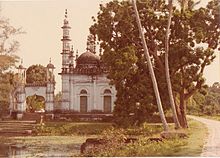|
Satkhira District
The Satkhira District (Bengali: সাতক্ষীরা জেলা, pron: Shatkhira, lit.Seven cucumbers) is a district in southwestern Bangladesh and is part of Khulna Division. It lies along the border with West Bengal, India. It is on the bank of the Arpangachhia River. The largest city and headquarter of this district is Satkhira.[3][4][5] AdministrationThe district consists of two municipalities, seven upazilas, 79 union porishods, 8 thana (police station) and 1,436 villages. The upazilas are:[6]
The two municipalities are Satkhira and Kalaroa. GeographySatkhira District has an area of 3,817 square kilometres (1,474 sq mi). It is bordered to the north by Jessore District, on the south by the Bay of Bengal, to the east by Khulna District, and to the west by North 24 Parganas and South 24 Parganas districts of West Bengal, India. The annual average maximum temperature reaches 35.5 °C (95.9 °F); minimum temperature is 12.5 °C (54.5 °F). The annual rainfall is 1710 mm (67 in). The main rivers are the Kopotakhi river across Dorgapur union of Assasuni Upazila, Morichap River, Kholpetua River, Betna River, Raimangal River, Hariabhanga river, Ichamati River, Betrabati River and Kalindi-Jamuna River.[9] ClimateTropical savanna climates have a monthly mean temperature above 18 °C (64 °F) in every month of the year and typically a pronounced dry season, with the driest month having precipitation less than 60mm (2.36 in) of precipitation. The Köppen Climate Classification subtype for this climate is "Aw" (tropical savanna climate).[10]
Demographics
According to the 2022 Census of Bangladesh, Satkhira District had 566,752 households and a population of 2,196,582 with an average 3.85 people per household. Among the population, 360,699 (16.42%) inhabitants were under 10 years of age. The population density was 575 people per km2. Satkhira District had a literacy rate (age 7 and over) of 75.32%, compared to the national average of 74.80%, and a sex ratio of 1009 females per 1000 males. Approximately, 19.67% of the population lived in urban areas. The ethnic population was 3,865.[1]
Satkhira had a 47% Hindu population in 1941 dominated by Scheduled Castes, with several thanas in the present district having a Hindu majority. During the massive riots in the 1950s and 1960s most of the Hindus there fled to neighboring India. The population of Hindus and Christians has remained constant since 1981, but their percentages have fallen massively. Christians live mainly in Kalaroa and Tala upazilas. Economy Economoy of Satkhira is mainly Agriculture based. But it has diverse opportuniy of economic prosperity. One land port (Bhomra) and several export producs make Satkhira as the next properious district of Bangladesh. Most of the peoples of the southern part of Satkhira depend on pisciculture, locally called gher. Main fruits are aam (mango), jaam (blackberry), kathal (jackfruit), kola (banana), pepe (papaya), lichoo (litchi), naarikel (coconut) and peyara (guava). Farms are 86 dairies, 322 poultry farms, 3,046 fisheries, 3,650 shrimp farms, 66 hatcheries and one cattle breeding centre. Export products
Points of interest Sundarbans is the largest single block of tidal halophytic mangrove forest in the world, is a World Heritage Site, and covers an area of 5,747 square kilometres (2,219 sq mi). The region is home to many ancient buildings and temples such as Sultanpur Shahi Mosque (500 years old) and Pir-e-Kamel Kari Hafez Sah-Sufi Jonab Hazrat Maolana Azizur Rahman (Rh) was a Muslim Sufi Saint and local ruler Kalimakhali, assasuni upozila in Satkhira (now in Bangladesh). Attractions also include the mangrove forest at Kaligonj Upazila. This forest, named Basjharia Joarar Ban, is popularly known as the forest of BADHA. The Joarar Ban is a cause of friction between the Bangladesh and Indian border.[citation needed] InfrastructureLand ports India-Bangladesh (Bhomra land port): 200 yards distant BGP camp from the main port. The Bhomra land port is the second largest in Bangladesh. The Bhomra land customs station was inaugurated in 1996. TransportRoads and highways are Satkhira-Khulna, Satkhira-Jessore, Satkhira-Assasuni-Ghola, Satkhira-Kaligonj-Shyamnagar. Satkhira-Kaligonj-Shyamnagar is very bad due to the conductor's corruption.[citation needed] EducationRecently established one medical college, 79 colleges, one primary teacher's training institute, 421 high schools, 41 junior high schools, 259 madrassas, and 822 government primary schools. Some of the notable educational institutions are:
Digital SatkhiraIn 1994, a few young people started a computer training center as a business and prepared some talents who later started other computer businesses and ultimately created the idea of digital Satkhira. Slowly the computer replaced manual machines in the office, banks, and other institutions. Schools and colleges started recruiting computer teachers. Many more young people started computer businesses. Manual (letter) printing presses switched to offset printing using the computer. In 1999 the Computer Association of Satkhira was established with 30 members. Computer Association of Satkhira regularly organizes computer fairs in various locations and offers basic and advanced Computer Trainings to increase ICT awareness and to introduce freelancing. Some of the computer fairs were supported by Bangladesh Computer Samity with the presence of Mustafa Jabbar, the current ICT minister. Notable people
Satkhira Government Hospital/Medical College
Private Hospital/Clinic
Private Diagnostic Centre
See alsoNotes
ReferencesWikimedia Commons has media related to Satkhira District. 
|
|||||||||||||||||||||||||||||||||||||||||||||||||||||||||||||||||||||||||||||||||||||||||||||||||||||||||||||||||||||||||||||||||||||||||||||||||||||||||||||||||||||||||||||||||||||||||||||||||||||||||||||||||||||||||||||||||||||||||||||||||||||||||||||||||||||||||||||||||||||||||||||||||||||||||







